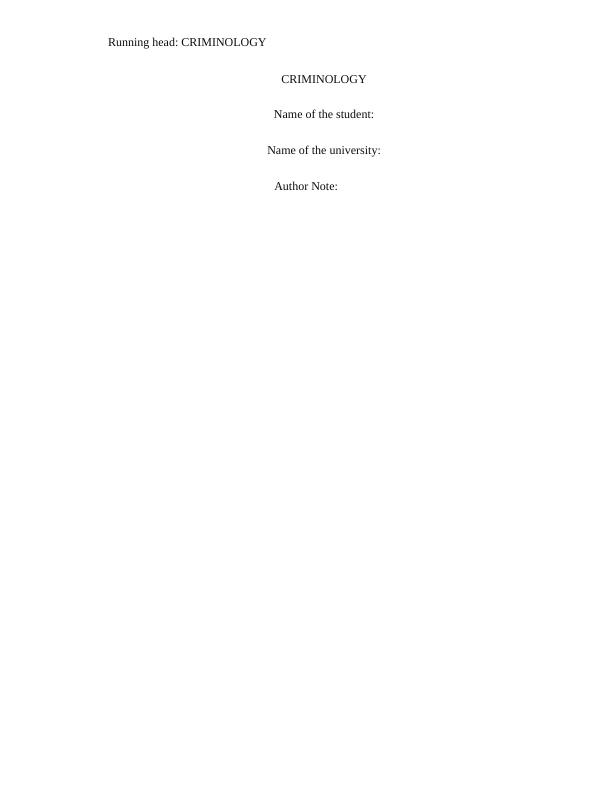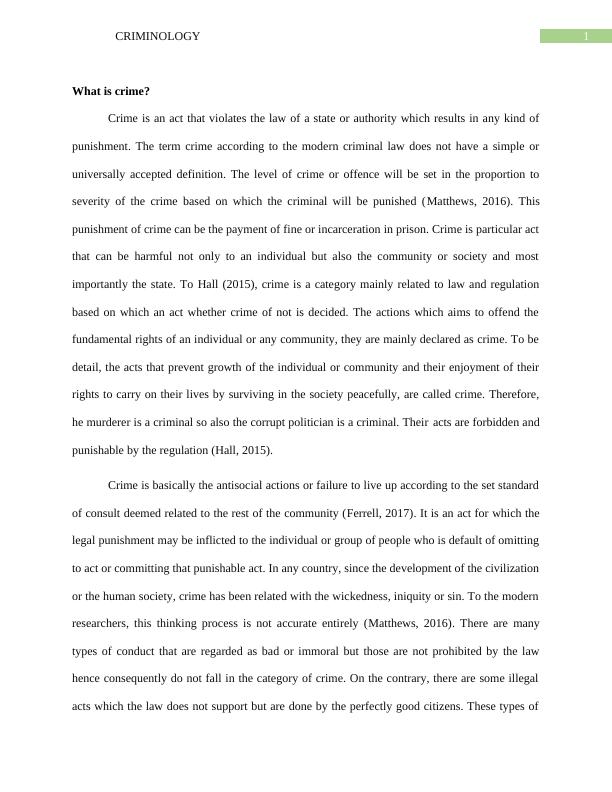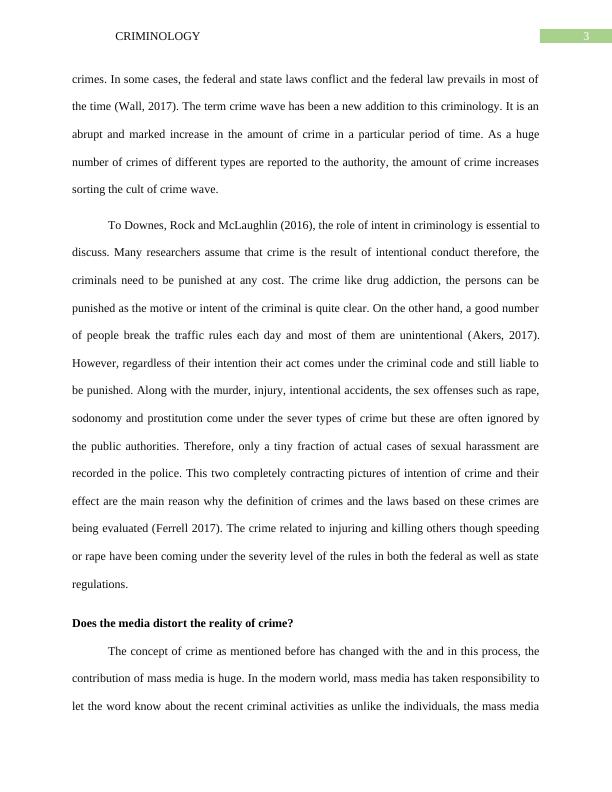Criminology: Understanding Crime and its Definition
Added on 2023-04-22
14 Pages4122 Words370 Views
Running head: CRIMINOLOGY
CRIMINOLOGY
Name of the student:
Name of the university:
Author Note:
CRIMINOLOGY
Name of the student:
Name of the university:
Author Note:

1CRIMINOLOGY
What is crime?
Crime is an act that violates the law of a state or authority which results in any kind of
punishment. The term crime according to the modern criminal law does not have a simple or
universally accepted definition. The level of crime or offence will be set in the proportion to
severity of the crime based on which the criminal will be punished (Matthews, 2016). This
punishment of crime can be the payment of fine or incarceration in prison. Crime is particular act
that can be harmful not only to an individual but also the community or society and most
importantly the state. To Hall (2015), crime is a category mainly related to law and regulation
based on which an act whether crime of not is decided. The actions which aims to offend the
fundamental rights of an individual or any community, they are mainly declared as crime. To be
detail, the acts that prevent growth of the individual or community and their enjoyment of their
rights to carry on their lives by surviving in the society peacefully, are called crime. Therefore,
he murderer is a criminal so also the corrupt politician is a criminal. Their acts are forbidden and
punishable by the regulation (Hall, 2015).
Crime is basically the antisocial actions or failure to live up according to the set standard
of consult deemed related to the rest of the community (Ferrell, 2017). It is an act for which the
legal punishment may be inflicted to the individual or group of people who is default of omitting
to act or committing that punishable act. In any country, since the development of the civilization
or the human society, crime has been related with the wickedness, iniquity or sin. To the modern
researchers, this thinking process is not accurate entirely (Matthews, 2016). There are many
types of conduct that are regarded as bad or immoral but those are not prohibited by the law
hence consequently do not fall in the category of crime. On the contrary, there are some illegal
acts which the law does not support but are done by the perfectly good citizens. These types of
What is crime?
Crime is an act that violates the law of a state or authority which results in any kind of
punishment. The term crime according to the modern criminal law does not have a simple or
universally accepted definition. The level of crime or offence will be set in the proportion to
severity of the crime based on which the criminal will be punished (Matthews, 2016). This
punishment of crime can be the payment of fine or incarceration in prison. Crime is particular act
that can be harmful not only to an individual but also the community or society and most
importantly the state. To Hall (2015), crime is a category mainly related to law and regulation
based on which an act whether crime of not is decided. The actions which aims to offend the
fundamental rights of an individual or any community, they are mainly declared as crime. To be
detail, the acts that prevent growth of the individual or community and their enjoyment of their
rights to carry on their lives by surviving in the society peacefully, are called crime. Therefore,
he murderer is a criminal so also the corrupt politician is a criminal. Their acts are forbidden and
punishable by the regulation (Hall, 2015).
Crime is basically the antisocial actions or failure to live up according to the set standard
of consult deemed related to the rest of the community (Ferrell, 2017). It is an act for which the
legal punishment may be inflicted to the individual or group of people who is default of omitting
to act or committing that punishable act. In any country, since the development of the civilization
or the human society, crime has been related with the wickedness, iniquity or sin. To the modern
researchers, this thinking process is not accurate entirely (Matthews, 2016). There are many
types of conduct that are regarded as bad or immoral but those are not prohibited by the law
hence consequently do not fall in the category of crime. On the contrary, there are some illegal
acts which the law does not support but are done by the perfectly good citizens. These types of

2CRIMINOLOGY
crimes are conducted either intentionally or due to ignorance of the laws as not every law can fit
all the commonly accepted standard of conduct (Hall, 2015).
According to the researcher like Matthews (2016), crime is related with the acts like theft,
crime and murder which are prohibited in all around the world. Different countries have different
criminal laws bad these decide the criminal offence in that nation. Many of the researchers
working on the criminalization and their effect in the society and trying to deploy this
criminalization to be the procedure as the preemptive harm reduction technique. In this regard
the labelling theory and natural law theory can be discussed (Michalowski, 2016). the labelling
theory accompanies social stigma and the natural law theory relates the standards of morality and
contracts them. depending upon these theories and considering the human being to be a rational
being, all types of laws are made (Downes, Rock & McLaughlin, 2016). The state has absolute
power to severely restrict the liberty pf the persons to commit any type of crime. In such the state
and federal penal codes differentiate among the codes related to the serious crimes and from
those which are comparatively less grave. The serious crimes are termed as felonies and the
others are misdemeanors. Despite of being so, the crimes accepted as felonies in some state, are
misdemeanors on the other (Akers, 2017). For example, the city of New York driving whole
intoxicated is misdemeanor if it is the first offence but becomes a felony if it is second offence.
The crime and their outcome mainly depend upon the governmental bodies where the
person lives. In a developed country, the people are subjected to three types of regulations in a
given time (Downes, Rock & McLaughlin, 2016). The first set is set by the federal statute, the
second one by the state government and the final set of rules are enacted by the local government
or the municipal ordinances. The local issues like braking of traffic rules or noise control. On the
other hand, the federal and state governments judge the crimes depending upon the severity of
crimes are conducted either intentionally or due to ignorance of the laws as not every law can fit
all the commonly accepted standard of conduct (Hall, 2015).
According to the researcher like Matthews (2016), crime is related with the acts like theft,
crime and murder which are prohibited in all around the world. Different countries have different
criminal laws bad these decide the criminal offence in that nation. Many of the researchers
working on the criminalization and their effect in the society and trying to deploy this
criminalization to be the procedure as the preemptive harm reduction technique. In this regard
the labelling theory and natural law theory can be discussed (Michalowski, 2016). the labelling
theory accompanies social stigma and the natural law theory relates the standards of morality and
contracts them. depending upon these theories and considering the human being to be a rational
being, all types of laws are made (Downes, Rock & McLaughlin, 2016). The state has absolute
power to severely restrict the liberty pf the persons to commit any type of crime. In such the state
and federal penal codes differentiate among the codes related to the serious crimes and from
those which are comparatively less grave. The serious crimes are termed as felonies and the
others are misdemeanors. Despite of being so, the crimes accepted as felonies in some state, are
misdemeanors on the other (Akers, 2017). For example, the city of New York driving whole
intoxicated is misdemeanor if it is the first offence but becomes a felony if it is second offence.
The crime and their outcome mainly depend upon the governmental bodies where the
person lives. In a developed country, the people are subjected to three types of regulations in a
given time (Downes, Rock & McLaughlin, 2016). The first set is set by the federal statute, the
second one by the state government and the final set of rules are enacted by the local government
or the municipal ordinances. The local issues like braking of traffic rules or noise control. On the
other hand, the federal and state governments judge the crimes depending upon the severity of

3CRIMINOLOGY
crimes. In some cases, the federal and state laws conflict and the federal law prevails in most of
the time (Wall, 2017). The term crime wave has been a new addition to this criminology. It is an
abrupt and marked increase in the amount of crime in a particular period of time. As a huge
number of crimes of different types are reported to the authority, the amount of crime increases
sorting the cult of crime wave.
To Downes, Rock and McLaughlin (2016), the role of intent in criminology is essential to
discuss. Many researchers assume that crime is the result of intentional conduct therefore, the
criminals need to be punished at any cost. The crime like drug addiction, the persons can be
punished as the motive or intent of the criminal is quite clear. On the other hand, a good number
of people break the traffic rules each day and most of them are unintentional (Akers, 2017).
However, regardless of their intention their act comes under the criminal code and still liable to
be punished. Along with the murder, injury, intentional accidents, the sex offenses such as rape,
sodonomy and prostitution come under the sever types of crime but these are often ignored by
the public authorities. Therefore, only a tiny fraction of actual cases of sexual harassment are
recorded in the police. This two completely contracting pictures of intention of crime and their
effect are the main reason why the definition of crimes and the laws based on these crimes are
being evaluated (Ferrell 2017). The crime related to injuring and killing others though speeding
or rape have been coming under the severity level of the rules in both the federal as well as state
regulations.
Does the media distort the reality of crime?
The concept of crime as mentioned before has changed with the and in this process, the
contribution of mass media is huge. In the modern world, mass media has taken responsibility to
let the word know about the recent criminal activities as unlike the individuals, the mass media
crimes. In some cases, the federal and state laws conflict and the federal law prevails in most of
the time (Wall, 2017). The term crime wave has been a new addition to this criminology. It is an
abrupt and marked increase in the amount of crime in a particular period of time. As a huge
number of crimes of different types are reported to the authority, the amount of crime increases
sorting the cult of crime wave.
To Downes, Rock and McLaughlin (2016), the role of intent in criminology is essential to
discuss. Many researchers assume that crime is the result of intentional conduct therefore, the
criminals need to be punished at any cost. The crime like drug addiction, the persons can be
punished as the motive or intent of the criminal is quite clear. On the other hand, a good number
of people break the traffic rules each day and most of them are unintentional (Akers, 2017).
However, regardless of their intention their act comes under the criminal code and still liable to
be punished. Along with the murder, injury, intentional accidents, the sex offenses such as rape,
sodonomy and prostitution come under the sever types of crime but these are often ignored by
the public authorities. Therefore, only a tiny fraction of actual cases of sexual harassment are
recorded in the police. This two completely contracting pictures of intention of crime and their
effect are the main reason why the definition of crimes and the laws based on these crimes are
being evaluated (Ferrell 2017). The crime related to injuring and killing others though speeding
or rape have been coming under the severity level of the rules in both the federal as well as state
regulations.
Does the media distort the reality of crime?
The concept of crime as mentioned before has changed with the and in this process, the
contribution of mass media is huge. In the modern world, mass media has taken responsibility to
let the word know about the recent criminal activities as unlike the individuals, the mass media

End of preview
Want to access all the pages? Upload your documents or become a member.
Related Documents
Criminology .lg...
|9
|1974
|383
Crime and Societylg...
|8
|2278
|472
Comparison of Positivist and Classical School of Criminologylg...
|9
|2520
|492
Approaches for Crime Preventionlg...
|6
|1407
|65
Principles of Criminal Law: Concepts, Criminalisation and Punishmentslg...
|6
|1329
|96
Different Perspectives on Defining Crimelg...
|5
|2004
|266
